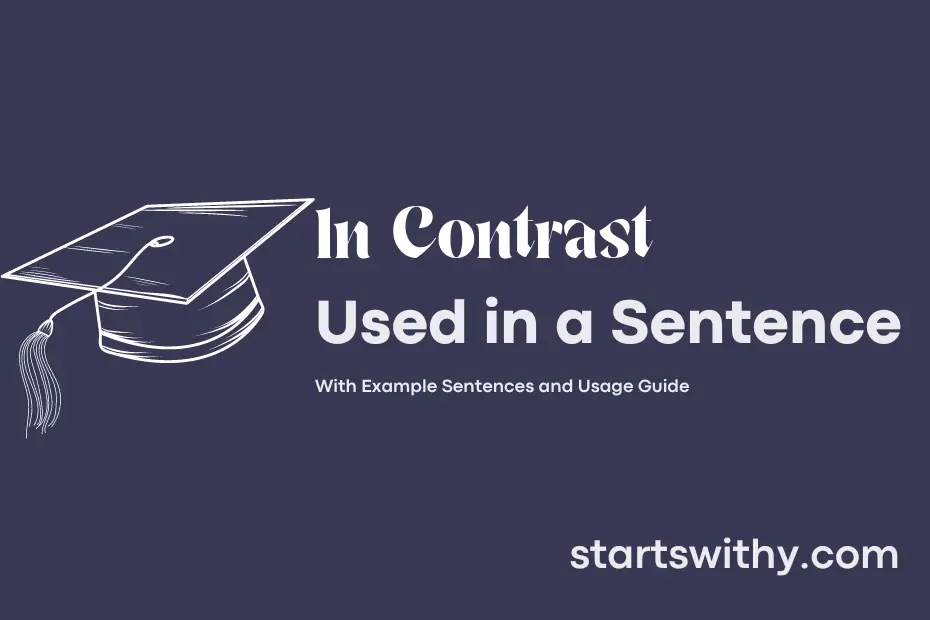Have you ever wondered how to effectively show the differences between two ideas in your writing? When you want to highlight contrast or distinguish between two opposing concepts, using an “in contrast” sentence can be a powerful tool.
“In contrast” is a phrase commonly used to introduce a sentence that contrasts with or contradicts the information presented in the previous sentence. This structure is essential in both academic and everyday writing to showcase distinctions, compare ideas, or emphasize differences between two subjects.
7 Examples Of In Contrast Used In a Sentence For Kids
- In contrast, the sun is hot and the moon is cool.
- Birds can fly, but fish swim in contrast.
- In contrast to a big elephant, a tiny ant is very small.
- Dogs bark loudly, in contrast to cats who meow softly.
- In contrast to summer, winter is cold.
- Red apples are sweet, in contrast to sour lemons.
- In contrast to daytime, nighttime is dark.
14 Sentences with In Contrast Examples
- In contrast to last semester, this year I am taking on more extracurricular activities.
- Studying during the day is completely different from cramming all night, in contrast to what some students prefer.
- In contrast to traditional lectures, online classes offer more flexibility.
- Some students enjoy group projects, in contrast to those who prefer working alone.
- In contrast to the previous syllabus, this year’s curriculum has more practical assignments.
- For some students, studying in quiet libraries is ideal, in contrast to those who prefer the hustle and bustle of coffee shops.
- In contrast to attending physical classes, online lectures allow students to rewind and rewatch them.
- In terms of career choices, some students prefer following their passion, in contrast to those who prioritize stable income.
- In contrast to relying solely on textbooks, some students prefer watching educational videos for better understanding.
- For many students, the transition from high school to college is a challenging one, in contrast to those who adapt easily.
- Some students excel in exams, in contrast to those who struggle with test anxiety.
- In contrast to students in other countries, Indian college students face more pressure from family expectations.
- Some students prefer studying alone for exams, in contrast to those who believe in group study sessions.
- In contrast to their classmates, some students prefer taking naps during breaks instead of socializing.
How To Use In Contrast in Sentences?
Using In Contrast in a sentence can help highlight differences between two or more subjects. To use In Contrast correctly, follow these simple steps:
-
Identify the two subjects or ideas you want to compare in your sentence. For example, “Cats are usually independent animals, in contrast to dogs, which are known for their loyalty.”
-
Place In Contrast after the first subject or idea, followed by a comma to separate it from the second subject or idea.
-
Ensure that the subjects or ideas you are comparing are related in some way but have notable differences. This will help make your comparison clear and effective.
-
Remember to use In Contrast when you want to emphasize differences between the two subjects or ideas, rather than similarities.
-
Practice using In Contrast in sentences to become more comfortable with incorporating it into your writing. This will help you enhance your ability to compare and contrast different concepts effectively.
Overall, using In Contrast is a valuable tool for drawing attention to distinctions between subjects or ideas in a sentence. By following these steps, you can effectively incorporate In Contrast into your writing and improve your ability to compare and contrast different elements.
Conclusion
In contrast, the variety of examples provided throughout this article demonstrate how this keyword can be used to highlight differences or opposing ideas within sentences. By using “in contrast,” writers can clearly convey distinctions between concepts, viewpoints, or events. This phrase serves as a useful tool for emphasizing comparisons and drawing attention to contrasting elements within a narrative or argument.
Employing “in contrast” effectively can improve the clarity and coherence of written communication, allowing readers to easily grasp the juxtaposition of ideas being presented. Whether used in academic essays, articles, or other forms of written work, this phrase helps to guide readers through contrasting points, enhancing the overall structure and impact of the text.



